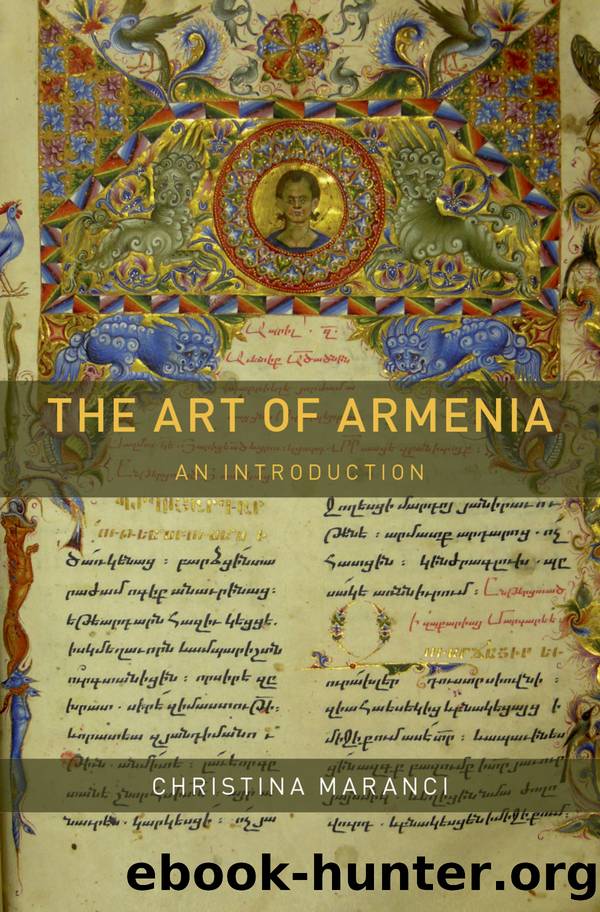The Art of Armenia by Maranci Christina;

Author:Maranci, Christina;
Language: eng
Format: epub
Publisher: Oxford University Press, Incorporated
Published: 2018-02-15T00:00:00+00:00
The decoration of the Haghpat bell tower demonstrates the mobility of building ideas across Anatolia and the South Caucasus in the early thirteenth century. Aside from the integration of the muqarnas form drawn from Islamic architectural tradition, the pipe molding design demonstrates a familiarity with and appreciation of Georgian architectural traditions. At the eleventh-century Cathedral of Samtavisi in eastern Georgia, for example, window moldings sprout a variety of independent designs, including crosses.30
Such mobility is also evident in the zhamatun of the monastery of Gandzasar, located in the southern region of Armenia, ruled by the princes of KhachÄn. First mentioned in the tenth century, Gandzasar was developed further by the prince Hasan-Jalal Dawla, who erected the church dedicated to Surb Karapet (John the Baptist) in 1238.31 During this era, Gandzasar served not only as the seat of the KhachÄn princes, but also as an episcopal see. After the fall of the patriarchate in Sis in the fourteenth century, Gandzasar became the headquarters of the regional catholicate of Albania (Aghuankâ).
The zhamatun was also founded by Hasan and his wife, Mamkan. Atabek, Hasanâs son, completed it around 1261 after his fatherâs death. As at Haghpat, the plan is large and rectangular, with intercrossed rib arches resting on freestanding piers at the west. Unlike the Haghpat zhamatun, however, the central vault does not repeat the design of the intersecting grid, but consists of a muqarnas with a skylight, as at the Holy Apostles zhamatun in Ani. On the west façade, the doorway and the window are framed by an elaborate carved molding, forming a rectangular zone rising almost to the roof level (Figure 5.10). Within this molding, two bas-relief birds face each other, flanking a rectangular window, their long tail feathers raised upward. They perch on an inner molding that frames the window and the door below, joining at the floor level with the outer molding to form profiled doorposts (jambs). The portal comprises a pointed arch of twisted and tendril moldings; the tympanum features interlocking circles of maroon, gray, and beige stone. The façade thus combines geometric boldness and abstraction with delicate carving. The designs of the framing moldings are particularly noteworthy: the medallions, teardrop forms, stars, and rectangles are not, like the birds above the doorway, raised reliefs, but are deeply undercut, perhaps with the use of a drill, appearing almost as perforations in the masonry skin.
Download
This site does not store any files on its server. We only index and link to content provided by other sites. Please contact the content providers to delete copyright contents if any and email us, we'll remove relevant links or contents immediately.
The Japanese by Christopher Harding(1017)
Watercolor With Me in the Forest by Dana Fox(716)
A Theory of Narrative Drawing by Simon Grennan(703)
The Story of the Scrolls by The Story of the Scrolls; the M(693)
Glittering Images: A Journey Through Art From Egypt to Star Wars by Camille Paglia(613)
Boris Johnson by Tom Bower(587)
The Art and Science of Drawing by Brent Eviston(563)
This Is Modern Art by Kevin Coval(561)
Frida Kahlo by Frida Kahlo & Hayden Herrera(551)
AP Art History by John B. Nici(537)
Banksy by Will Ellsworth-Jones(530)
War Paint by Woodhead Lindy(517)
Van Gogh by Gregory White Smith(514)
Scenes From a Revolution by Mark Harris(510)
Draw More Furries by Jared Hodges(508)
Ecstasy by Eisner.;(501)
About Looking by John Berger(496)
100 Greatest Country Artists by Hal Leonard Corp(494)
Young Rembrandt: A Biography by Onno Blom(484)
